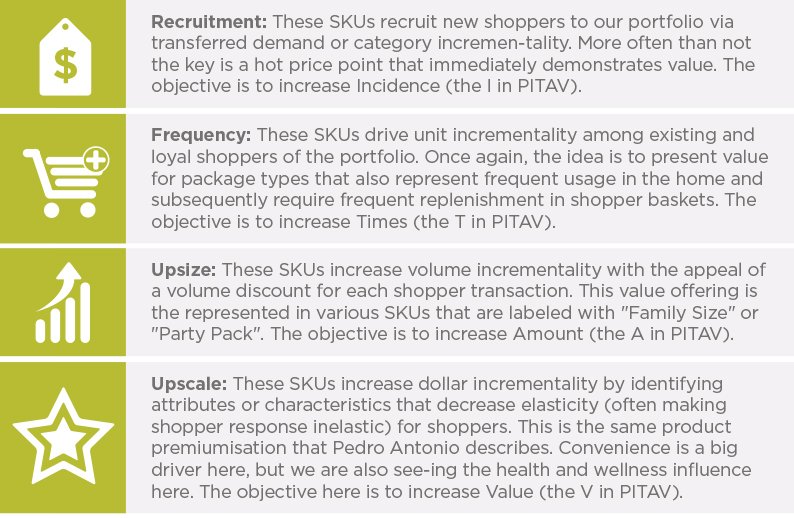
In the last blog, I described the PITA Model that we were introduced to while at The Coca-Cola Company. A quick review of that blog will familiarize you with the PITA Model if it is new to you.
PITA presents a strategic understanding of the opportunities and gaps for a given market and which metric to target. In certain markets, the issue might be Incidence (I). In others markets the opportunity could be Times (T) or Amount (A). To capture what our partner Pedro Antonio Garcia Lopez calls product premiumisation, we extend PITA to PITAV by introducing the average sales price shopper paid as Value (V).
Once we can isolate the place to focus in PITAV, it becomes clear how we need to evaluate our assortment and review the presence and absence or overlap of roles in the portfolio. Coke also had an approach for this and classified SKUs into four categories:

With an understanding of the SKU roles and their ability to address various objectives that they facilitate in PITAV, it is important to map these back to the channels and retailers that make up those channels.
Shopping and shoppers are driven by the occasion that the purchase facilitates. These vary across channels and retailers since different shoppers are in these outlets for these different reasons. This is why Middlegame prefers to deploy our Competitive Interaction Analysis (CIA)® platform by channel and retailer for assortment scenario planning. This holistic approach allows clients to incorporate multiple channel and retailers into an overall strategy that allows the precise number of SKUs to affect overall portfolio value.
Middlegame is the only ROMI consultancy of its kind that offers a holistic view of the implications of resource allocation and investment in the marketplace. Our approach to scenario-planning differs from other marketing analytics providers by addressing the anticipated outcome for every SKU (your portfolio and your competitors’) in every channel. Similar to the pieces in chess, each stakeholder can now evaluate the trade-offs of potential choices and collectively apply them to create win-win results.
